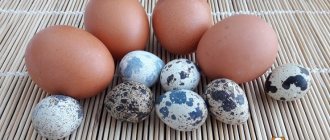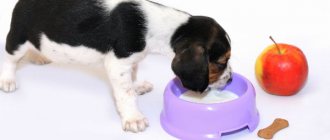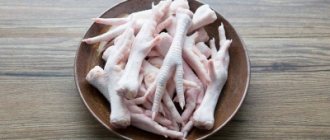Category: Nutrition, Dog care
And again about feeding dogs. Readers are wondering if dogs can fish. After all, you want to diversify the menu of your beloved pet. In this article, we will find out what fish you can eat, what fish is prohibited, and in what form you can offer fish to dogs.
Previously, we have already discussed with you the possibility of a dog drinking milk as an adult and the usefulness of this product specifically for older individuals. And we touched on the topic of banning sweets, especially chocolate. Well, now let's get down to the fish question.
I want to say right away that fish is good for people and dogs. Meat and fish food (animal protein) should be the main one in the dog’s diet. This is especially important during the puppy’s growth period.
Feed fish no more than 70% of the total protein feed of animal origin. Less is possible, but more is not. It is better to replace meat food with fish food 2-3 times a week. Fish contains a lot of vitamins: A, D and B12, iodine and phosphorus are included. As dog owners confirm, if their pets regularly eat fish, the coat becomes thicker and more pleasant to the touch. The condition of the skin and joints improves. But excessive consumption disrupts metabolism, leads to urolithiasis and other troubles.
There is a rumor that you cannot feed your dog river and lake fish. The fact is that there are many helminths in fish living in fresh water. And in order not to infect the pet, owners avoid giving such products. And in vain. If it has been heat-treated or frozen, then feel free to offer it as food. Especially if you exclude the insides and head.
With products of marine origin, not everything is so simple. Some species are strictly forbidden to include a tailed friend in their diet. Let's look at what types and why they should not be given to dogs.
What kind of fish can dogs be given?
The digestive system of tetrapods is different from that of humans. Animals can accumulate hair in their stomachs, rough food is easily digested, and sometimes even bones come out without difficulty.
However, this does not mean that you can feed your furry friend anything. Allowed types of fish for dogs:
- all salmon (coho salmon, char, brown trout, Chinook salmon, chum salmon, pink salmon, sockeye salmon, salmon, whitefish);
- river trout;
catfish;- herring;
- sardine;
- anchovies;
- grayling;
- hake;
- haddock;
- whiting;
- flounder.
Restrictions
Not all fish are suitable for dogs.
The following species should not be given raw:
- sardinops;
- Chukuchan;
- bream;
- pike;
- carp;
- anchovy;
eel-pout;- sprat;
- smelt;
- ide;
- herring;
- capelin;
- sardine;
- sprat
This is not a complete list. Quadrupeds should not be given varieties that contain thiaminase in their tissues. This component destroys vitamin B.
The enzyme is found in the internal organs and head. Thiaminase is deactivated at high temperatures.
You can add fish to your animal’s diet by boiling it first. Just don't get carried away.
Some varieties contain trimethylamine oxide. This organic substance negatively affects the absorption of iron into the blood, causing anemia. Feeding animals with some varieties leads to infertility, anemia and other ailments.
To prevent iron deficiency anemia, it is recommended to give boiled fish or add iron-containing foods to food. The first option is preferable so as not to cause an excess of iron in the body. Pets are allowed:
hake;- pollock;
- silver hake;
- pollock;
- whiting;
- pout.
Four-legged animals should not be given milk: the product is fatty and causes gastrointestinal upset.
It is not advisable to feed your pets fish pulp from the scombroid family because of the histamine it contains. If the product is stored incorrectly, dogs are at risk of food poisoning.
Poisonous fish species are prohibited. These species are rare, but you should be aware of them. This:
- temple;
- barbel;
- dog fish;
- Ottomans;
- Balkhash Marinka
Potential danger
Uncontrolled feeding of a dog with a product of dubious quality or inappropriate varieties provokes the development of health problems.
The main factors that can harm your pet include:
- Helminthiases. Feeding a dog a raw product is fraught with helminthic infestations. Marine and Pacific inhabitants suffer a special type of helminthiasis - anisakiasis. The larvae of the parasite infect all the insides, including the intestines, liver and muscles. To disinfect fish, carcasses are frozen for 14 days at a temperature of -18 0C or boiled for about 25 minutes.
- Presence of toxic substances. Polychlorinated biphenyls, dioxins, mercury and lead accumulate in fish that live in polluted waters or eat poor-quality feed. The most common types of toxins found in fish include eel, halibut, mackerel and herring.
- Presence of specific enzymes. Certain types of fish contain histamine, trimethylamine oxide and thiaminase, which are harmful to the health of the dog. Histamine is formed during improper storage and causes mackerel (scombroid) poisoning. Trimethylamine oxide is produced in cod, pollock, capelin, whiting and haddock and provokes iron deficiency anemia. Thiaminase is found in carp, sardine, anchovy, smelt, crucian carp, capelin and herring. It blocks and destroys thiamine molecules, which are necessary for the normal functioning of the nervous system. As a result of a lack of vitamin B1, dogs develop cardiovascular diseases, neuropathies and other neurological pathologies.
Is it allowed to give to puppies?
Puppies, like adults, can and should be given fish products. This should be done with caution.
Important details:
The fish is given without bones and heads.- Before serving, the product should be passed through a meat grinder; grinding in a blender is allowed.
- Any fish must undergo heat treatment. The product is simmered over low heat for at least 15 minutes after boiling.
- For puppies, fish is mixed with porridge.
At what age can you give
Fish should appear in a dog's diet from 2.5-3 months . Puppies should be gradually fed the delicacy, making sure that they do not develop allergies.
Briefly about the main thing
- Fish is a nutritious, healthy food for dogs.
- It should not be used as the main source of protein; excess upsets the balance of nutrients and microelements.
- Dogs digest boiled fish worse than raw fish; if there is little of it in the diet, then it is better to simply freeze the product.
- A product with up to 8% fat content is more beneficial for dogs as a source of polyunsaturated fatty acids.
- Large breed dogs can eat fish with the head and small bones, small breeds can eat fish that has been thoroughly cleaned or minced through a meat grinder.
- Canned, smoked, dried, salted delicacies are contraindicated for dogs.
What type of fish is your dog’s favorite, which one does he eat more readily: river or sea? Share in the comments what fish dishes you prepare for your pet.
Did you like the article? Share it with your friends on social media. networks. This will help them get useful information and support our project.
How to feed fish correctly
Feeding raw fish is not recommended. Firstly, such a product can be dangerous to the health and life of the pet, and secondly, it contains helminths.
It is optimal to use frozen fillets or cooked fish. The bones need to be removed. This is especially true for feeding small dogs. They need to grind the pieces before feeding.
It is sometimes allowed to cook fish broth, it is important to ensure that it is low-fat. You can make soup by adding cereals and vegetables to it.
Popular questions
How to teach a dog to fish?
This is easiest to do in puppyhood. Start accustoming your dog to low-fat varieties from 4 to 5 months of age, give this product little by little, monitor for possible allergic reactions and signs of indigestion. Remember, allergies to raw fish are less common.
What kind of fish can a dog with allergies eat?
- low-fat river and white sea salt (gives the dog hypoallergenic protein);
- fish not affected by “herring disease” - anisakidosis (allergies are caused by helminth toxins);
- raw, fresh frozen.
Red - trout, salmon, salmon - on the contrary, is dangerous for dogs with allergies.
Don’t forget about dry “fish” food of super premium and higher classes. As a rule, they are positioned as hypoallergenic.
In what form and what kind of fish can be given and what not?
The product is not always given to animals in boiled form, which is not always healthy.
Choose:
- raw;
- salty;
smoked;- dried;
- fried.
It is allowed to give a dog a product that has lain at -22 °C for a day or has been at a temperature of -18 °C for two weeks. It is dangerous to give other types.
Salty
It is better to avoid salted fish: salt disrupts the water-salt balance, leading to serious illnesses.
It is allowed to feed your pet a small piece of lightly salted herring, but not more than twice a month. Stray dogs eat pickles, which help restore sodium salts in the body.
Smoked
Modern smoking is far from ideal. To save money, they use cheap chemical additives in which the product is soaked and then lightly smoked.
This kind of smoked fish should not be given - it harms the pancreas, liver, gastrointestinal tract, and causes allergies.
Dried
Dried fish is also prohibited. The product contains excessive amounts of salt, which is harmful to the animal.
As an exception, a small piece is allowed several times a year.
Fried
Fried food should not be given to animals. Fish is no exception. Overheated fat absorbed by the product leads to a number of diseases.
conclusions
When choosing a natural type of feeding, fish is an indispensable part of the diet. Not all varieties are equally useful. The fish must be frozen. Seafood, smoked food, canned food, dried fish are harmful to the dog. We organize a fish day 1-2 times a week.
Please follow and like us:
Nikitin Sergey
I write about dogs based on the experience and knowledge gained during my studies as a veterinarian, work in my specialty, and simply from observing my pets.
Fish soup or broth
Ferments are harmful to dogs, they make the animal sick, the stool is disrupted, the quality of the coat and the well-being of the shaggy friend deteriorate. It is better to avoid broths.
The exceptions are sick animals, nursing bitches, and puppies. The liquid should be non-greasy. Fish soup is allowed, but the share of the main product cannot exceed 15% of the total weight.
Food for an animal should not contain bones or entrails, only fish meat.
By-products
Heads
Fish heads should not be added to food for small dogs - the animal may choke. Sometimes these by-products are acceptable for shepherds, St. Bernards and other large breeds.
Raw pink salmon heads are especially useful, but regularly eating such food is fraught with problems with the gastrointestinal tract.
Fish bones
Boiled bones are allowed for consumption, but in small quantities.
Sharp bones must be removed from the fish before feeding. Fish fillets with bones clog the stomach and intestines. Babies sometimes develop obstruction, leading to death.
Is it possible to give your dog seafood?
It is possible, but only in boiled form. Be sure to boil shrimp, oysters, crayfish and squid. Otherwise, the dog will experience diarrhea. Lobsters are banned because they contain a lot of cholesterol. And too much consumption of them causes kidney problems or poisoning. Seafood causes allergies, so there is no need to give it to puppies. It's better to wait until they grow up. And even when feeding an adult dog for the first time, you need to carefully monitor its condition.
Each dog has a different attitude towards fish: some don’t like it, but for others there is nothing tastier in the world. Our dog refuses to eat raw fish, but his shaggy ears won’t stop him from eating boiled fish. What kind of fish does your dog prefer? Share with us in the comments.
Post Views: 785
Kinds
River fish
Animals rarely eat lake and river fish on their own. Red varieties are best. River trout is ideal. Before serving, it must be frozen or boiled so as not to infect the dog with worms.
Should I feed the sea
Such fish does not need to be frozen, because the presence of helminths in it is rare. The product is rich in vitamins, iodine, phosphorus, and fats.
Quadrupeds willingly consume sea creatures, which are tastier, more aromatic, and richer than river rocks.
What beneficial substances do dogs need in fish?
Fish is a storehouse of useful minerals, trace elements, and vitamins. Animals need the product no less than people.
Fish has high nutritional value; it contains a lot of protein, unsaturated fatty acids, and amino acids.
The most important microelements:
- copper;
- lithium;
- zinc;
iron;- cobalt;
- iodine;
- phosphorus.
Fish contains a large amount of vitamins and essential natural chondroprotectors that protect joints and bones and prevent their early destruction.
Antioxidants are indispensable for animals, especially in old age. The components are found in salmon and cod.
Fish fat
This product can and should be given. It contains Omega 3, Omega 6. These components protect the heart and blood vessels from the negative influence of the environment, help normalize blood pressure, and prevent inflammatory processes.
Fat contains vitamins A, D, E. It is indispensable for young dogs, whose growing body requires a full range of microelements.
For puppies from 1.5-2 months, it is enough to mix 1 tsp into their food daily. fat, starting the first week with 3-5 drops. For adult animals, the supplement is recommended in courses. The method of use and dosage will be advised by your veterinarian.
How much fish products should I give for a complete diet?
Fatty fish has a ratio of 1:1 to animal muscle meat, moderately fatty fish has a ratio of 1:2.5, and lean fish has a ratio of 1:1.5. If a dog’s daily diet is equal to 3% of its weight, then we carry out the following calculation:
| weight , kg | Daily food intake, (3% of weight), g | Porridge (30%), g | Oily fish , g | Other (vitamins, brewer's yeast, gran. chalk, etc.), g |
| 30 | 900 | 270 | 600 | 30 |
Add vegetables to taste. When choosing other fish varieties, recalculate as indicated above.
Seafood, dried, smoked, canned, salted and fish heads are not suitable for a complete diet of an animal. They will lead to bad consequences and will only bring harm.
Dry food based on seafood
Some breeders feed their dogs not regular food, but dry food that contains seafood.
This option is acceptable, but provided that the products are purchased in a super premium class. This “drying” contains all the necessary elements, microelements, vitamins and additives. The food is balanced and suitable for all four-legged animals. You can choose food based on your pet’s age, breed and taste preferences.
“Drying” should be given as constant nutrition. It is impossible to replace the vitamins contained in fish products with food. You should feed the animal either prepared food or regular food, including in the diet everything that the pet needs.
Can dogs eat ear? Pros and cons
For many owners, it becomes a discovery that it is undesirable to give broth to dogs. The thing is that it promotes the production of gastric juice. On a regular basis, this can lead to the development of gastritis and ulcers. Rich broth negatively affects the pancreas and liver. The first decoction may contain toxins and undigested fats. Broth cooked for yourself is also dangerous because it often contains salt and spices. On the other hand, ear contains glucosamine, natural gelatin, and several other substances that are good for joints and promote the absorption of carbohydrates.
From the above, the conclusion follows: the first water when cooking the broth should be drained, it is better to cook the fish soup using low-fat varieties of fish and not give it to the dog regularly. If you pamper your pet occasionally there will be nothing wrong.
No matter how healthy the fish is, you should always take into account the food preferences of your pet and the peculiarities of its digestion.
When is it better to refrain from feeding fish?
You need to select products carefully, following all the rules. Animals should not be given backbones, gills, entrails or bones.
When boiling fish, you need to first clean it, removing everything unnecessary. This food should not be offered to dogs that are allergic to one or another variety.
This usually applies to red fish species. You should start adding a new component to food carefully and gradually to see how the body reacts.
What are the dangers of using
If the rules are not followed, the animal may develop allergies, gastrointestinal problems, and even die.
You should not give dogs cleaned seafood (mussels, rapana, shrimp and others) from the table or seafood in its pure form. Sharp edges injure not only the mucous membrane in the oral cavity, but also the intestinal walls.
How to properly prepare fish dishes for dogs?
The method of preparing the dish depends on your preferences. If you give fresh fish, then first freeze it, and after thawing, clean it of gills, scales, and entrails.
By boiling fish, you make it safer, but at the same time it retains a minimal amount of nutrients. The optimal cooking time is 10-20 minutes.
Fish cuisine is given on separate days and is not mixed with meat. If the dog has to be accustomed to a new product, then fish can be given in small portions as a supplement to the diet. There is no need to force feed your pet seafarers. Their absence is compensated by adding fish oil or flour to the main menu.
Pet food is always prepared without adding salt or seasonings. For a puppy, varieties are selected more carefully; to start complementary feeding, take lean fish. After boiling and peeling, it is mixed with cereals and vegetables, dietary supplements. If the dog responds well to the new food, you can gradually increase its fat content.
If your four-legged friend is on a natural diet, he needs fish. Choose fresh and high-quality products, prepare them correctly, then the dog will be well-fed and healthy.











